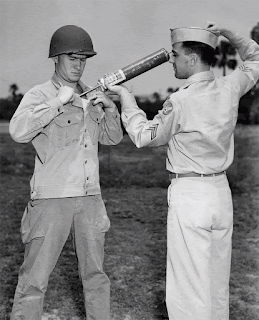WHAT HAPPENED TO THE TYPHUS VACCINE?Troops ready to land
(Wikipedia)
America’s baptism of fire in WWII was “Operation Torch”, the code name for the invasion of North Africa. The troops faced numerous hazards. Among them was epidemic typhus, a louse-transmitted scourge in the local population, likely to infect troops that cannot easily bathe or change clothes. Acquired by rubbing the infected feces of body lice into skin during scratching, epidemic typhus had swept away millions during and after the previous World War. Fearing that another epidemic could ruin the upcoming invasion, planners reached for two weapons: insecticides and vaccination.
On the advice of the newly-formed U.S.A. Typhus Commission (USATC), directed by Brig. Gen. Leon Fox (chief military health officer for the North Atlantic) and Fred Soper (an epidemiologist instrumental in malaria and yellow fever control in South America), all invading troops carried two-ounce cans of MYL powder, a pyrethrin-based insecticide, and all received a new and as yet minimally-tested vaccine against typhus.
The journey to a vaccine began in 1909 with the discovery by Charles Nicolle, in Algeria, that body lice transmitted the unseen germ. The next year, studying typhus in Mexico, Howard Ricketts
 |
| Howard Ricketts (Wikipedia) |
found the tiny organism in lice, a finding soon confirmed by others. Early in WWI, A Brazilian scientist working in Germany, Henrique da Rocha Lima, and a Czeck scientist, Stanislaus von Prowazek, both working in a camp holding Russian prisoners, many with typhus, visualized the tiny causative organisms inside the cells lining the louse intestine. Rocha Lima named the organisms Rickettsia prowazeki after Howard Ricketts and von Prowazek, both of
 |
| Stanislaus von Prowazek(Wikipedia) |
whom died of typhus during their investigations (Rocha Lima also contracted the disease but survived). Attempts at culturing failed, however.
Inability to grow the organisms hampered vaccine development. A Polish scientist, though, did produce a vaccine in the 1930s, used on a significant scale. The scientist, Rudolf Weigl, in Lvov, Poland, invented a technique to inject Rickettsia organisms into the rectums of sterile lice using a fine glass tube and operating under a binocular microscope. Lice were placed in small boxes strapped to the legs of humans for feeding, both before and again after anal injection, to
 |
| Rudolf Weigl (Wikipedia) |
enhance growth of the Rickettsia. Weigl then delicately removed the infected intestines, ground them with phenol as a sterilizer, and used the material as vaccine fluid. Three doses over a month offered enough protection to modify or prevent illness or death. The vaccine was used in and around Poland and traveled to China, where it saved hundreds of missionaries. The Germans, after invading Lvov, realized the benefits of the vaccine for their troops. Ramping up production impelled Weigl to mechanize the louse injections, so that one operator could inject 50 lice at a time and about 1000 an hour. A skilled dissector
| Body louse feeding (CDC website) |
 |
| Weigl vaccine, packaged (Wiki-Commons) |
After the war scientists attempted to grow the organism in animal tissues such as rodent lungs, with some success. French workers in North Africa developed such vaccines and tried another made from murine typhus organisms, a related Rickettsia that can cause mild human disease. More importantly, Herald R. Cox (after whom
 |
| Herald Cox (Wikipedia) |
Coxiella burnetii, the cause of Q fever, is named), of the U.S. Public Health Service, succeeded in growing R prowazeki in the yolk sac of chick embryos. Further steps, especially extraction by ether, led to a more potent and easier to make vaccine, eventually produced by Squibb and Lederle in the U.S. and Connaught Laboratories in Canada. Human trials undertaken in Bolivia and Spain gave indefinite results, but the U.S. military decided, to be safe, to vaccinate the troops invading North Africa. In spite of a severe epidemic in the area only a handful of troops came down with mild cases. Proper studies among subjects in Cairo proved that the “Cox vaccine”, as it was known, was effective in protecting against severe, though not all, disease.
The MYL powder eliminated lice from clothing easily but its potency died out quickly. The next year, though, DDT came into use. This seemingly magic chemical had been synthesized as early
 |
| Paul Müller (Wikipedia) |
as 1874 but had no useful function. In 1939, Paul H. Müller, a chemist working at the Swiss chemical firm, J.R. Geigy, while looking for a good insecticide, discovered the superior properties of DDT. Compared to MYL it had a much longer duration of action and soon replaced it. It was in use in Africa by early 1943. For delousing, the military ordered the local population to remove their clothing. Moslem women refused, however. So, Army personnel employed spray guns to blow the chemical between the clothing and skin, with the sleeves and legs tied off.
 |
| Spray gun for DDT (Wikipedia) |
Many millions of lives were saved with DDT. Paul Müller was awarded the Nobel Prize in Physiology or Medicine in 1948 despite the fact that he was neither a physician nor a physiologist.
The Weigl vaccine, after the war, gave way to the easier “Cox vaccine” whose production continued until 1970. By then, the widespread use of DDT and the introduction of effective antibiotics had terminated typhus as a world problem. The former scourge of armies, prisons, ships, and famine presently exists only in isolated pockets.
SOURCES:
Allen, Arthur. The Fantastic Laboratory of Dr. Weigl. 2014; W W Norton
Snyder, J C. “Typhus Fever in the Second World War”. 1947; California Medicine 66 (1): 3-10
Ecke, et al. “The Effect of Cox-Type Vaccine on Louse-Borne typhus Fever.” 1945; Am J Trop Med25: 447-62.
Lindenmann, Jean. “Typhus Vaccine Developments from the First to the Second World War.” 2002; Hist Phil Life Sci. 24: 467-485.

No comments:
Post a Comment
Comments are welcome. Especially new knowledge, insights, and sources of further information.